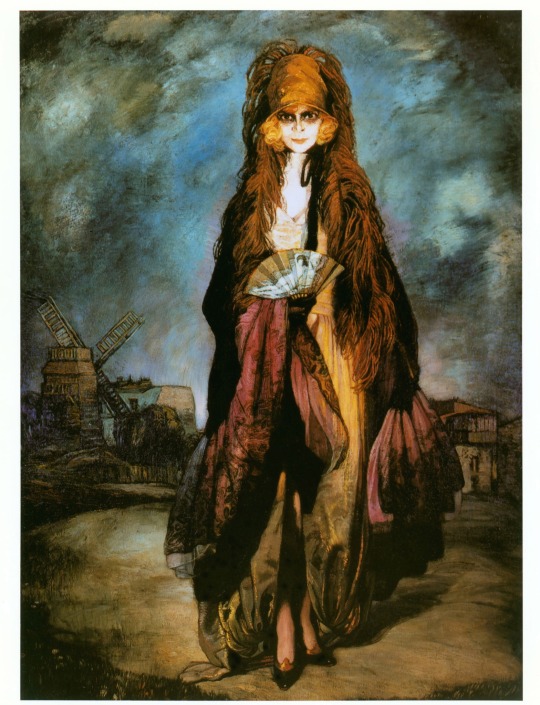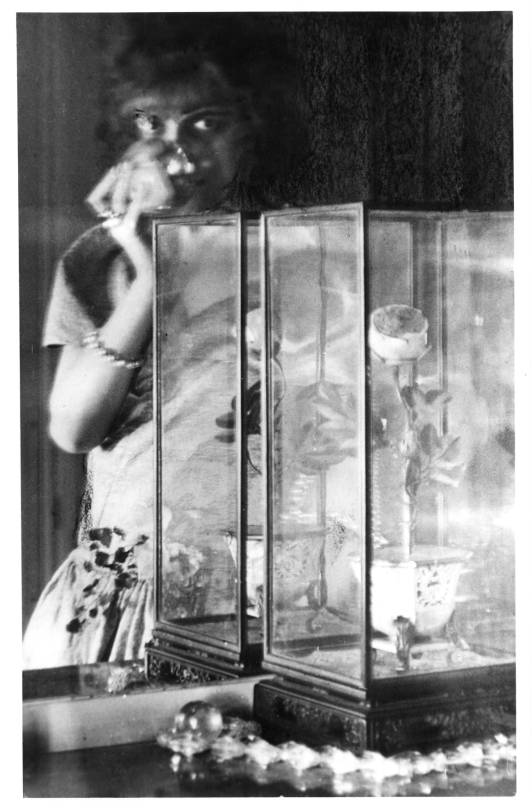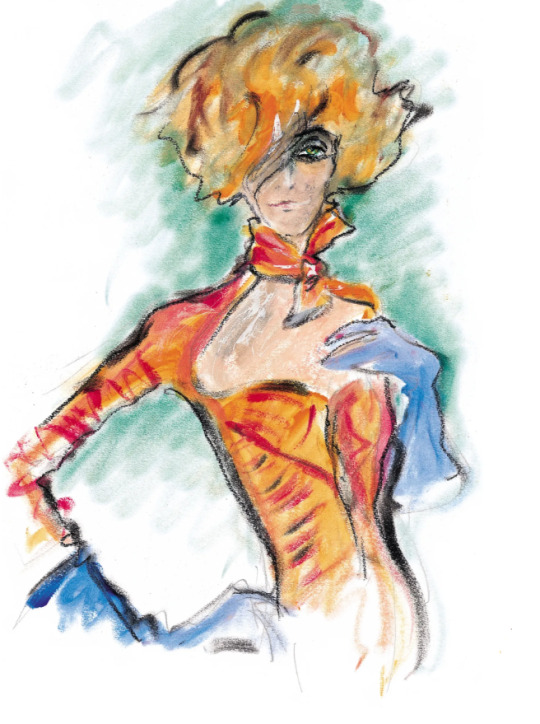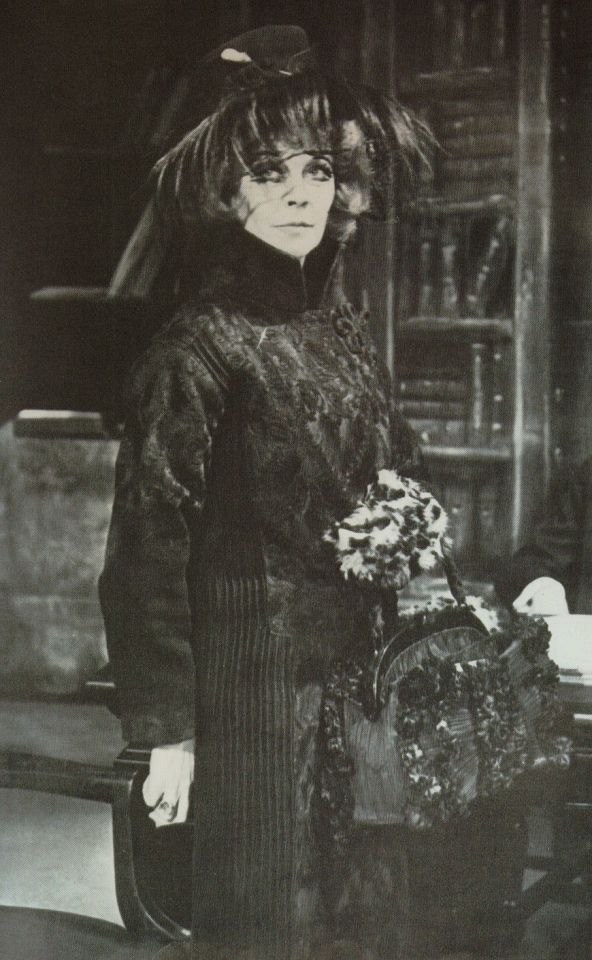Text

It's Marchesa Luisa Casati's 8 year anniversary on Tumblr 🥳
#8 year tumblrversary#tumblr milestone#marcehsa casati#marchesa casati#la casati#la marchesa#luisa casati#marchesa luisa casati#luisa marchesa casati stampa di soncino#marquise casati#marquise casati stampa di soncino#marquise de casati#marchesa
5 notes
·
View notes
Text

Marchesa Luisa Casati, 1923. Found in the collection of Espacio Cultural Ignacio Zuloaga (Ignacio Zuloaga y Zabaleta (Spanish, 1870-1945),
#marchesa luisa casati#painting#1923#art#marchesa casati#la casati#la marchesa#luisa casati#luisa marchesa casati stampa di soncino#marquise de casati#marquise casati stampa di soncino#marquise casati#marchesa#marchesa luisa#marquise luisa casati#marquise casati stampa#luisa casati stampa#casati stampa#marchesa luisa casati stampa#Ignacio Zuloaga y Zabaleta#Ignacio Zuloaga#Zuloaga
30 notes
·
View notes
Text
Casati set about transforming herself into the world's most amazing woman. She succeeded brilliantly. Weird and wonderful...both scary and hypnotic.
– Colin McDowell, Sunday Times of London
#luisa casati#la casati#la marchesa#marchesa luisa casati#luisa marchesa casati stampa di soncino#marquise casati#marchesa casati#marquise casati stampa di soncino#marquise de casati#marchesa#luisa amman#luisa amman stampa#marquise amman stampa#quote#transforming quote#amazing quote#brilliantly quote#weird quote#wonderful quote#Colin McDowell#sunday times
9 notes
·
View notes
Photo

1922 Man Ray, Marchesa Luisa Casati.
"In 1922, Luisa visited a young and still unknown photographer named Man Ray. In his autobiography, the American tells the story of the photo that became the most famous of all the representations of the Marchioness Casati (...) "I drew a few where one could distinguish a semblance of face; On one of the negatives, we saw three pairs of eyes. It could have been mistaken for a surreal version of the Medusa. It was precisely this photo that delighted her: I had made a portrait of her soul, she said, and she ordered dozens of copies from me. I wish my other clients had been so easy to please. The photo of the marquise went around Paris. Figures from the most closed circles began to come, all expecting miracles. I had to leave my hotel room and find a real studio. » (x)
#1922#portrait#man ray#marchesa luisa casati#luisa casati#marchesa casati#marquise casati#Marquise luisa casati#la Marquise#luisa amman casati#Luisa Adele Rosa Maria von Amman#Luisa Adele Rosa Maria Amman#Luisa Amman#Marquise Casati Stampa di Soncino#Marchesa Casati Stampa di Soncino#Luisa Marchesa Casati Stampa Di Soncino#Luisa Casati Stampa di Soncino#Marchesa Casati Stampa
151 notes
·
View notes
Quote
Marchesa Luisa Casati spent recklessly and, beyond the sums she lavished on her wardrobe, she hosted parties of astounding extravagance. Many were held at the Palazzo Venier dei Leoni, but the one that entered Venetian folklore was the 18th-century costume ball for which Luisa took over the whole of Piazza San Marco, hiring 200 black servants, all dressed by Leon Bakst, to hold back the watching public.
Christie’s
#quote#christie’s#Christie’s quote#marchesa luisa casati#luisa casati#la casati#luisa amman#marquise casati#recless quote#lavished quote#lavished#recklessly#astounding quote#astounding#extravagance quotes#extravagance#marchesa casati#luisa amman casati#Luisa Adele Rosa Maria von Amman#Luisa Adele Rosa Maria Amman#Marquise Casati Stampa di Soncino#Marchesa Casati Stampa di Soncino#Luisa Marchesa Casati Stampa Di Soncino#Luisa Casati Stampa di Soncino#Marchesa Casati Stampa#Marquise luisa casati#la Marquise#luisa#casati#stampa
7 notes
·
View notes
Photo

Master of Sketches: Design sketch by Karl Lagerfeld. To reinvent Marchesa Luisa Casati, the designer channelled her idiosyncratic spirit in a series of sketches and photographs of Carine Roitfeld, the editor of French Vogue:
“She has the same bone structure and wildly daring fashion sense,” Lagerfeld says. “She plays a modern Casati, but the drama of Casati was that she was not playing.”
Karl Lagerfelds sketch of Carine Roitfeld, the editor of French Vogue in an evening dress by Gucci.
#2003#design sketch#sketch#karl lagerfeld#marchesa luisa casati#drama#gucci dress#gucci#luisa casati#marchese casati#luisa amman#Marquise Casati Stampa di Soncino#Marchesa Casati Stampa di Soncino#Luisa Casati Stampa di Soncino#Marchesa Casati Stampa#Luisa Marchesa Casati Stampa Di Soncino#luisa amman casati#Luisa Adele Rosa Maria von Amman#Luisa Adele Rosa Maria Amman#Marquise luisa casati#la Marquise#marquise casati#stampa#casati#amman#roitfeld#lagerfeld
9 notes
·
View notes
Text
"The Marchesa Luisa Casati was immensely rich and almost equally strange. She gave fantastic dressing-up parties in her Venetian palazzo (now the Guggenheim Museum) and posed for portraits by Boldoni and Man Ray. She didn’t like sex much, but she and d’Annunzio were partners in making spectacles of themselves. He hung the bushes in her garden with flowers made of Murano glass. She wrote to him ‘the glass-maker has given me two large green eyes as beautiful as the stars, do you want them?’ He said she was: The only woman who ever astonished me."
Words by Lucy Hughes-Hallett, author of The Pike: Gabriele d’Annunzio, Poet, Seducer and Preacher of War.
#Lucy Hughes-Hallett#quote#quotes#casati quotes#marchesa quotes#marquise quotes#luisa marchesa casati stampa di soncino#marchesa casati#la marchesa#marquise casati#marchesa casati stampa#marquise casati stampa di soncino#luisa amman#marchesa luisa casati#luisa casati#marchesa#luisa amman casati#Gabriele d’Annunzio#strange quotes#la marquesa luisa casati#marquise luisa casati#la casati#luisa casati stampa#stampa#marquise casati stampa#la marquise casati stampa#luisa marquise casati stampa#luisa marchesa casati stampa#marquise de casati#marquise cadati
16 notes
·
View notes
Photo

George Lepape, Vogue Cover of a woman eating. Marquise Marchioness Casati (Marchesa Luisa Casati), Palais Rose, Mode d'Automne, Chapeaux et Tissus Nouveaux. August 15 1927.
#1927#illustration#george lepape#vogue#vogue cover#cover#cover art#1927 cover#1927 illustration#lepape#palais rose#august issue#august issue 1927#mode d'automne#autumn fashion#20s fashion#20s illustrations#marchesa#marchesa luisa casati#marchesa casati#luisa casati#luisa amman#luisa amman casati#Luisa Adele Rosa Maria von Amman#Luisa Adele Rosa Maria Amman#Marquise Casati Stampa di Soncino#Marchesa Casati Stampa di Soncino#Luisa Marchesa Casati Stampa Di Soncino#Luisa Casati Stampa di Soncino#Marchesa Casati Stampa
71 notes
·
View notes
Photo


1965 Vivien Leigh (52) as Contessa Sanziani in the play La Contessa.
The Contessa of the title was actually based on a real person, the eccentric Marchesa Luisa Casati, one of the most notorious women of the 20’s, who scandalized polite society with her desire to be “a living work of art”; which once manifested itself in a dress made of illuminated lightbulbs.
The play was financed by a film company that hoped a success on the stage would lead to a film, but sadly after a try out in Newcastle, Liverpool and Manchester the play folded without ever coming to London. Perhaps audiences were not yet ready to accept Vivien in a character role that played down her looks; because whilst the Marchesa Luisa Casati had been a glamourous figure in her youth, immortalized on canvas by Boldini, the play takes place in her twilight years, when aged 71 she was broke, washed up and living in London.
Even Vivien admitted “If I appeared in a flashback as the beauty the Marchesa Luisa Casati was supposed to have been, I think we would have had a success.” But the decision to play an older woman was a conscious one, and she saw the play as a “bridge to parts where I don’t have to be a beautiful woman. I thought it would make me acceptable as an actress that didn’t have to be cast that way anymore.”
Play: La Contessa. Role: Contessa Sanziani. Playwright: Paul Osborn from the novel by Maurice Druon. Theatre: previews in Newcastle, Liverpool and Manchester. Opening Night: 6 April 1965.
Photo: Rita Maylon collection Vivien Leigh Circle Archive THM/530 – V&A Museum.
#1965#play#la contessa#Vivien Leigh#contessa sanziani#Rita Maylon collection#paul osborn#leigh#the contessa#stage#luisa casati#la marchesa#marchesa#la casati#la marquise#amman#luisa amman#marchesa luisa casati#marquise casati#luisa amman casati#Luisa Adele Rosa Maria von Amman#Luisa Adele Rosa Maria Amman#Marquise Casati Stampa di Soncino#Marchesa Casati Stampa di Soncino#Luisa Marchesa Casati Stampa Di Soncino#Luisa Casati Stampa di Soncino#Marchesa Casati Stampa#Marquise luisa casati#marquise
31 notes
·
View notes
Photo

Paul Cesar Helleu, and Marchesa Luisa Casati in Indo-Persane costume designed by Leon Bakst in the garden of Palazzo Fortuny (Palazzo Pesaro degli Orfei), Photo by Mariano Fortuny, September 1913.
About Palazzo Fortuny:
Situated in the Gothic Palazzo Pesaro degli Orfei in Campo San Beneto; the building was transformed by Mariano Fortuny into his own photography, set-design, stagecraft, fabric-creation and painting atelier: the building still testify to all of these activities, with various art and tapestries collections. The museum also hosts temporary art exhibitions, all of which closely connected to the spirit of its founder.
#1913#marchesa luisa casati#paul cesar helleu#palazzo fortuny#Pesaro degli Orfei#venice#Gothic Palazzo#gothic#costumes#1910s costumes#1910s costume design#leon bakst#bakst#1913 costume#luisa casati#casati#marchesa#marquise#divine marchesa#luisa amman#luisa amman casati#Luisa Adele Rosa Maria von Amman#Luisa Adele Rosa Maria Amman#Marquise Casati Stampa di Soncino#Marchesa Casati Stampa di Soncino#Luisa Marchesa Casati Stampa Di Soncino#Luisa Casati Stampa di Soncino#Marchesa Casati Stampa#Marquise luisa casati#la Marquise
25 notes
·
View notes
Photo

Credit: Alamy
The secret life of Venice
Favourite spot
Home - the Palazzo Papadopoli. We have always lived here, since we were born. We live on the top floor, and the rest of the palace is now the Aman hotel.
We'd rather not tell you about...
...Trattoria Antiche Carampane, which serves the absolute best granseola tagliolini (spider-crab pasta).
Top tip
Naranzaria, a tiny osteria next to the Rialto bridge, is a brilliant stop for an Aperol Spritz
Best buys
Our father's [Count Giberto's] handmade Murano glasses. Or our slippers, of course...(x)
#venice#travel#guggenheim venice#secret venice#favourite spot#things to do#top tip#best buys#guggenheim
8 notes
·
View notes
Text
“Quite suddenly and simply by chance, I once met a bizarre lady while taking tea with some friends in London. She arrived wearing black velvet from head to foot, her mouth painted blood red, and carrying a very tall umbrella with a decorated handle. And, you must understand, this ensemble was being worn in the middle of the day. This picturesque ruin of a woman was very tall and thin, and gave the impression of formidable strength. It was then I was introduced to the Marchesa Luisa Casati for the first and last time. She had made her entrance into that room looking wonderful and saying very little. She wasn’t beautiful-she was spectacular. Here was a woman possessing a presence one would never forget.”
- Quentin Crisp
#quote#quentin crisp#quentin crisp quote#marchesa luisa casati#luisa casati#la marchesa#luisa marchesa casati stampa di soncino#marchesa casati#marquise casati#marquise casati stampa di soncino#marchesa#marchesa casati stampa#luisa amman#luisa amman casati#luisa casati stampa#stampa#marquise casati stampa#la marquise casati stampa#luisa marchesa casati stampa#luisa marquise casati stampa#marquise de casati#marquise#caracter quote#strenght
10 notes
·
View notes
Photo

2003 Karl Lagerfeld, Carine Roitfeld as Marchesa Luisa Casati. Roitfeld in a slashed mink bolero by Rick Owens for Revillon over a brocaded top by Tom Ford for YSL. Costume jewelry by Buccellati; pearls by Chanel.
Tribute to Marchesa Luisa Casati.
“Her contemporaries couldn’t decide if she was a vampire, a bird of paradise, an androgyne, a goddess, an enigma, or a common lunatic. Her clothes were esoteric and memorable––i.e., the suit of armor pierced with hundreds of electric arrows; the iridescent necklace of live snakes; the headdress of peacock tail feathers accessorized with chicken’s blood. When she really wanted to outdo herself, she wore nothing…Venetians were regularly treated to Casati strolling through St. Mark’s Square perfectly nude beneath a fur coat, accompanied by two cheetahs.” (x)
The New Yorker, September 22, 2003, p. 172.
#2003#karl lagerfeld#marchesa luisa casati#tribute#homage#inspiration#roitfeld#lagerfeld#luisa casati#casati#marchesa#marquise#divine marchesa#luisa amman#luisa amman casati#Luisa Adele Rosa Maria von Amman#Luisa Adele Rosa Maria Amman#marquise casati#marchesa casati#Marchesa Casati Stampa#Marquise Casati Stampa di Soncino#Marchesa Casati Stampa di Soncino#Luisa Marchesa Casati Stampa Di Soncino#Luisa Casati Stampa di Soncino#Marquise luisa casati#marquesa casati#la marquise#Marchesa Luisa Casati.
14 notes
·
View notes
Photo

Mario Natale Biazzi, portrait of Marchesa Luisa Casati, s.d. Olio su tela, 43,40 x 41,40 cm.
Collezione Paolo Schmidlin.
#painting#mario natale biazzi#portrait#marchesa casati#la marchesa#the divine marchesa#divine marchesa#collezione paolo schmidlin#marquise casati#marquise luisa casati#luisa amman#amman#casati#stampa#Marquise Casati Stampa di Soncino#Marchesa Casati Stampa di Soncino#Luisa Marchesa Casati Stampa Di Soncino#Luisa Casati Stampa di Soncino#Marchesa Casati Stampa#marquise#marquesa casati#la marquise#Marchesa Luisa Casati.#luisa#luisa casati#marchesa luisa casati#marchesa#luisa amman casati#Luisa Adele Rosa Maria von Amman#Luisa Adele Rosa Maria Amman
22 notes
·
View notes
Photo

1900 Carlo Bugatti, Bench, with painted inscription Casati (Marchesa Luisa Casati). A stained wood, vellum, copper with pewter and brass inlay, and silk bench.
Provenance: Marquise Luisa Casati (Marchesa Luisa Casati).
Sotheby’s
#1900#bench#carlo bugatti#casati#marchesa luisa casati#marquise casati#Sotheby’s#marquise#marchesa#la marquise#bugatti#la marchesa#Marchesa Casati Stampa#marchesa casati#luisa casati#Luisa Casati Stampa di Soncino#Luisa Marchesa Casati Stampa Di Soncino#Marchesa Casati Stampa di Soncino#Marquise Casati Stampa di Soncino#luisa amman casati#luisa amman
18 notes
·
View notes
Quote
Tall and gaunt with heavily made-up eyes, Marchesa Luisa Casati represented a past age of splendour when a few beautiful and wealthy women adopted an almost brutally individualistic way of living and presenting themselfes to the public.
Elsa Schiaparell
#quote#elsa schiparelli#schiaparelli#schiaparelli quote#past age#past age quotes#splendour#splendour quote#wise quotes#life quotes#wise#marchesa luisa#casati#la casati#marchesa casati#la marquise#marquise casati#Marquise luisa casati#luisa amman casati#Luisa Adele Rosa Maria von Amman#Luisa Adele Rosa Maria Amman#Luisa Amman#marquise#Marquise Casati Stampa di Soncino#Marchesa Casati Stampa di Soncino#Luisa Marchesa Casati Stampa Di Soncino#Luisa Casati Stampa di Soncino#Marchesa Casati Stampa
13 notes
·
View notes
Photo

Marchesa Luisa Casati, circa 1915
Luisa Casati (1881- 1957), Italian heiress, muse, and patroness of the arts in early 20th-century Europe. Ca. 1915.
#1915#photography#marchesa luisa casati#Luisa Casati Stampa di Soncino#la marcehsa casati#la marquise#la luisa#casati#stampa#casati stampa#amman#luisa amman#luisa amman casati#Luisa Adele Rosa Maria von Amman#Luisa Adele Rosa Maria Amman#Marquise Casati Stampa di Soncino#Marchesa Casati Stampa di Soncino#Luisa Marchesa Casati Stampa Di Soncino#Marchesa Casati Stampa#Marquise luisa casati#marquise#marquise casati#costume
21 notes
·
View notes